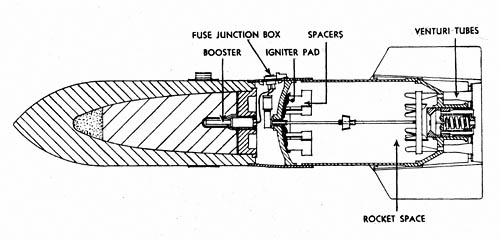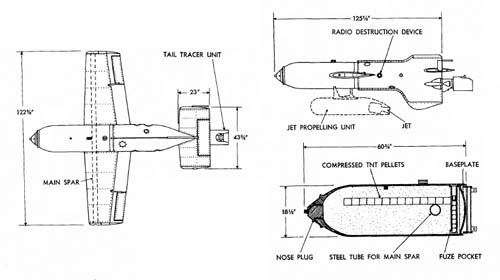
The German high explosive bomb, H. s. 293, is a radio-controlled, jet-propelled glider, designed primarily for use against merchant ships and naval craft. It is usually released when the plane is in level flight at an altitude of from 3,000 to 5,000 feet, and at a distance of from 3 to 5 miles from the target. However, the bomb is not launched directly at the target, but is released during flight on a course parallel to that of the target. Upon release, the jet propulsion automatically goes into action, and thereafter the flight of the bomb is controlled from the airplane by radio. It is apparently aimed by eye alone and, as an aid to visibility, the tail is provided with flares and an electric lamp for night use.
H. s. 293 is made up of six main parts: the bomb which forms the forward part of the fuselage; the rear portion of the fuselage containing the radio control unit, a gyro, and a destructor; the jet propulsion unit (slung from the base of the bomb); the wings, or planes; the tail plane; and the tail tracer unit. The bomb case is of forged steel and is filled with approximately 600 pounds of 60/40 poured Amatol. A cylinder of compressed T.N.T. pellets lies in this filling, running forward from the fuze pocket. The control unit consists of a radio receiver, a motor generator, and a relay unit. A radio destruction device is located directly under the radio receiver and consists of a small charge with a clockwork fuze.
Propulsion is accomplished by means of a bi-liquid rocket unit. Wings and tail planes are of aerofoil section and the skin is of thin sheet alloy. Ailerons are provided for lateral control, and an elevator is concealed in the tail plane. Five flare candles burning consecutively make up the tail tracer unit.
SPECIFICATIONS
| Overall length | |
148 ins. |
| Length of bomb | |
60 3/4 ins. |
| Diameter of bombV18 1/2 ins. |
| Total weight (approx.) | |
1,980 lbs. |
| Span of mainplanes | |
122 5/8 ins. |
| Span of tailplanes | |
43 3/4 ins. |
| Diameter of jet-propulsion unit (approx.) | |
12 ins. |
| Weight of bomb (approx.) | |
1,320 lbs. |
| Color | |
Sky-blue |
German: p. 315
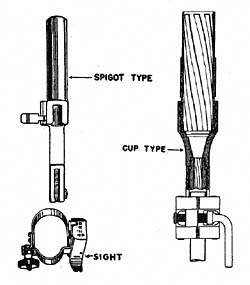 The two standard German rifle dischargers are the cup type (Schiessbecher) and the spigot type. The former is made of steel and consists of a rifled barrel which screws into a holder fitted with a clamp for attaching it to the rifle barrel. There are no gas ports, and varying ranges are obtained by altering the elevation of the rifle by the aid of the sighting attachment. The latter type consists of a hollow tubular spigot about one inch in diameter, terminating in a part resembling the hilt of a bayonet. It is fitted to the rifle in the same manner as a bayonet, and is locked in position by a spring-loaded bolt. The hollow tailpiece of the grenade is fitted over the spigot, and on firing the propelling cartridge, the gasses pass out of the barrel of the rifle through the spigot and into the hollow tailpiece to propel the grenade. Both a swing-over blade front sight and a rear sight are provided.
The two standard German rifle dischargers are the cup type (Schiessbecher) and the spigot type. The former is made of steel and consists of a rifled barrel which screws into a holder fitted with a clamp for attaching it to the rifle barrel. There are no gas ports, and varying ranges are obtained by altering the elevation of the rifle by the aid of the sighting attachment. The latter type consists of a hollow tubular spigot about one inch in diameter, terminating in a part resembling the hilt of a bayonet. It is fitted to the rifle in the same manner as a bayonet, and is locked in position by a spring-loaded bolt. The hollow tailpiece of the grenade is fitted over the spigot, and on firing the propelling cartridge, the gasses pass out of the barrel of the rifle through the spigot and into the hollow tailpiece to propel the grenade. Both a swing-over blade front sight and a rear sight are provided.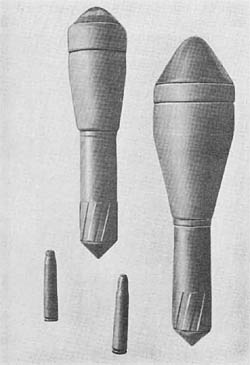 Two additional H.E.A.T. (hollow charge) armor piercing rifle grenades have recently been recovered and are illustrated herewith. They bear the designations
Two additional H.E.A.T. (hollow charge) armor piercing rifle grenades have recently been recovered and are illustrated herewith. They bear the designations 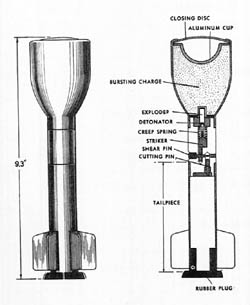 This grenade consists of a bell-shaped body of thin steel with a slightly convex aluminum closing disc, a graze fuze which screws into a cylindrical projection welded to the base of the body, and a finned tail unit. The bursting charge of cyclonite wax is cast around an aluminum hollow charge liner which is hemispherical in shape. A detonator and intermediary exploder are contained in an aluminum magazine which fits into the base of the main explosive cavity. The tail unit screws onto the base of the fuze housing and consists of a drawn-steel tube with six vanes formed in pairs. The cartridge is of the 7.92 mm small arm type with an undyed hollow wooden bullet.
This grenade consists of a bell-shaped body of thin steel with a slightly convex aluminum closing disc, a graze fuze which screws into a cylindrical projection welded to the base of the body, and a finned tail unit. The bursting charge of cyclonite wax is cast around an aluminum hollow charge liner which is hemispherical in shape. A detonator and intermediary exploder are contained in an aluminum magazine which fits into the base of the main explosive cavity. The tail unit screws onto the base of the fuze housing and consists of a drawn-steel tube with six vanes formed in pairs. The cartridge is of the 7.92 mm small arm type with an undyed hollow wooden bullet.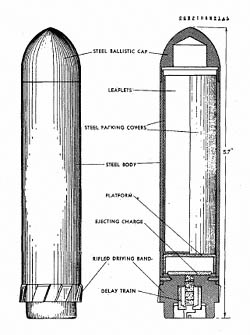 This grenade which is used for propaganda purposes consists of a cylindrical steel body with a pre-rifled base and a removable ballistic cap. The base of the grenade contains a 9-second delay fuze and an ejecting charge covered by a cardboard disc to prevent moisture from causing deterioration. Leaflets are inserted in two steel packing covers held loosely inside the case, and then the case and cap are varnished to protect them from rust. On firing, the flash from the propelling cartridge ignites the fuze and approximately 9 seconds later the ejecting charge explodes, blowing off the cap and forcing the leaflets out of the nose of the projectile.
This grenade which is used for propaganda purposes consists of a cylindrical steel body with a pre-rifled base and a removable ballistic cap. The base of the grenade contains a 9-second delay fuze and an ejecting charge covered by a cardboard disc to prevent moisture from causing deterioration. Leaflets are inserted in two steel packing covers held loosely inside the case, and then the case and cap are varnished to protect them from rust. On firing, the flash from the propelling cartridge ignites the fuze and approximately 9 seconds later the ejecting charge explodes, blowing off the cap and forcing the leaflets out of the nose of the projectile.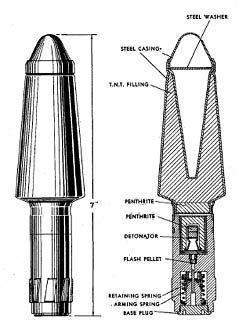 This grenade, while larger and of slightly different contour than that described on the preceding page, is basically the same in construction and operation. The body of pressed steel contains a steel cone around which the T.N.T. filler is cast, and at the bottom of the filler is an exploder pellet of penthrite wax. Two types of stem may be used, one entirely of light alloy and the other of plastic with a steel shank by which it is screwed onto the body. The booster assembly and the percussion type fuze are both located in the stem divided by a perforated septum which contains a small flash pellet. At the base of the stem is a rifled band which corresponds to the rifling on the discharger. The assembly is closed by a base plug.
This grenade, while larger and of slightly different contour than that described on the preceding page, is basically the same in construction and operation. The body of pressed steel contains a steel cone around which the T.N.T. filler is cast, and at the bottom of the filler is an exploder pellet of penthrite wax. Two types of stem may be used, one entirely of light alloy and the other of plastic with a steel shank by which it is screwed onto the body. The booster assembly and the percussion type fuze are both located in the stem divided by a perforated septum which contains a small flash pellet. At the base of the stem is a rifled band which corresponds to the rifling on the discharger. The assembly is closed by a base plug.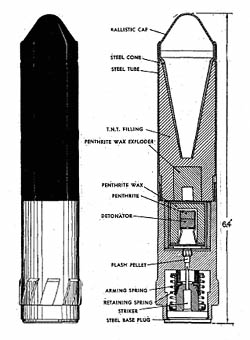 The Gewehr Panzergranate is constructed in two parts, the head and the stem. The head, a seamless steel tube fitted with a light ballistic cap, contains a hollow charge cone and an explosive filling of T.N.T. A cavity is provided in the rear portion of the main filling to take an exploder of penthrite wax. The stem of light alloy or aluminum is screwed onto the head of the grenade. It is divided into two compartments. The upper portion contains the booster which consists of a detonator surrounded by a penthrite wax filling contained in a light alloy case. The percussion type fuze is located in the lower part of the stem. In the septum is a small flash pellet held in place by a perforated screw plug. A pre-engraved driving band is formed on the outside of the grenade approximately 1/4 inch fromn the base. The entire assembly is closed by a base plug which positions the fuze by a stem which fits into a recess in the rear of the striker body.
The Gewehr Panzergranate is constructed in two parts, the head and the stem. The head, a seamless steel tube fitted with a light ballistic cap, contains a hollow charge cone and an explosive filling of T.N.T. A cavity is provided in the rear portion of the main filling to take an exploder of penthrite wax. The stem of light alloy or aluminum is screwed onto the head of the grenade. It is divided into two compartments. The upper portion contains the booster which consists of a detonator surrounded by a penthrite wax filling contained in a light alloy case. The percussion type fuze is located in the lower part of the stem. In the septum is a small flash pellet held in place by a perforated screw plug. A pre-engraved driving band is formed on the outside of the grenade approximately 1/4 inch fromn the base. The entire assembly is closed by a base plug which positions the fuze by a stem which fits into a recess in the rear of the striker body.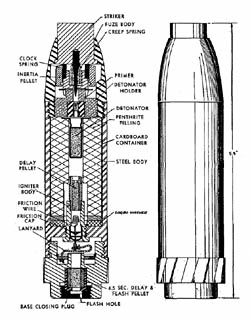 This grenade consists of a tubular steel body containing an explosive filler of penthrite wax, a detonator, a direct action nose fuze, a delay friction igniter, and a base assembly containing a self-destroying system. A diaphragm near the bottom of the grenade is threaded centrally to receive the friction igniter. The fuze and base assemblies are not integral parts of the grenade, but are screwed into the nose and base respectively. If the nose fuze does not function properly, the grenade is self-destructive. On firing, the flash from the propelling cartridge enters a hole in the base closing plug and ignites a 6.5 second delay pellet contained in a brass holder. This fires the friction igniter which, gives an additional delay of 4.5 seconds before setting off the detonator. The grenade may also be used as a hand grenade by removing the base assembly and pulling a cord attached to the friction igniter.
This grenade consists of a tubular steel body containing an explosive filler of penthrite wax, a detonator, a direct action nose fuze, a delay friction igniter, and a base assembly containing a self-destroying system. A diaphragm near the bottom of the grenade is threaded centrally to receive the friction igniter. The fuze and base assemblies are not integral parts of the grenade, but are screwed into the nose and base respectively. If the nose fuze does not function properly, the grenade is self-destructive. On firing, the flash from the propelling cartridge enters a hole in the base closing plug and ignites a 6.5 second delay pellet contained in a brass holder. This fires the friction igniter which, gives an additional delay of 4.5 seconds before setting off the detonator. The grenade may also be used as a hand grenade by removing the base assembly and pulling a cord attached to the friction igniter.